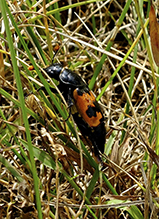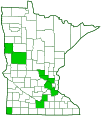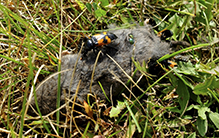margined burying beetle
(Nicrophorus marginatus)
Conservation • Description • Habitat • Ecology • Distribution • Taxonomy
|
|
||||||||||||||
Description |
Margined burying beetle is a large beetle. It occurs throughout the United States, in Mexico, and in southern Canada. In Minnesota it is uncommon statewide but common to abundant in some locations. It is active from late February to November but most active in the hot summer months from July to August. It is usually found in open fields and meadows. Adults feed mostly on small carrion. Margined burying beetle adult is 9⁄16″ to ⅞″ (13.9 to 22 mm) long. The body is moderately robust, elongate, somewhat flattened, and mostly black. The underside is covered with yellow hairs. The head and mouth parts are projected forward. The antennae are black and are abruptly widened at the tip (clubbed). They have 11 segments but the second segment is very small, making it appear that there are only 10 segments. The expanded portion of the club is mostly bright orange, black just at the base. It is covered with velvety hairs (setae). The hardened plate covering the thorax (pronotum) is nearly round and entirely black with no orange markings. It is sharply flattened at the edges with narrow margins at the sides and a broad margin at the base. The plate between the wing bases (scutellum) is visible, moderate-sized, and entirely black. The hardened wing covers (elytra) are truncate, appearing cut off at the tip and exposing 2 or 3 body segments. They are covered with long erect hairs and the lateral margins are folded under. The surface is smooth, not ridged. On each elytron there is a broad stripe on the lateral margin extending from the shoulder (humeral) angle almost to the wing tip, and two orange, horizontal bands. The front band is broad. It extends from the lateral stripe to the inner margin (suture) making a continuous band. The edges are sharply “toothed, as if tattered.” The rear band is narrower. It does not extend completely to the suture, and it is roundly lobed, not sharply toothed. The legs are black. The fourth segment (tibia) on each hind leg is slightly curved. The end part of each leg (tarsus), corresponding to the foot, has 5 segments. |
Size |
Total length: 9⁄16″ to ⅞″ (13.9 to 22 mm) |
Similar Species |
Habitat |
Open fields and meadows |
Ecology |
Season |
February to November |
Behavior |
After finding a carcass, the male will emit pheromones to attract a female. Together they will bury the carcass to keep it moist and prevent it being taken by a scavenger. Both adults feed the larvae. |
Life Cycle |
The female lays eggs close to the buried carcass. After they hatch the first stage (instar) larvae are fed by the adults. The adults overwinter. |
Larva Food |
Decaying flesh regurgitated by the adults. |
Adult Food |
Small carrion |
Distribution |
||
|
Sources |
|
| 9/5/2024 | ||
Occurrence |
||
Uncommon |
||
Taxonomy |
|
Order |
Coleoptera (Beetles) |
Suborder |
Polyphaga (Water, Rove, Scarab, Long-horned, Leaf, and Snout Beetles) |
Infraorder |
Staphyliniformia |
Superfamily |
Staphylinoidea (rove, ant-like stone, and carrion beetles) |
Family |
Silphidae (burying and carrion beetles) |
Subfamily |
Nicrophorinae |
Genus |
Nicrophorus (burying beetles) |
Subordinate Taxa |
|
|
|
Synonyms |
|
Nicrophorus guttulus labreae Nicrophorus investigator latifrons Nicrophorus lunatus Nicrophorus mckittricki Nicrophorus montezumae Nicrophorus obtusisculletum Silpha marginata |
|
Common Names |
|
margined burying beetle margined sexton beetle |
|
Glossary
Elytra
The hardened or leathery forewings of beetles used to protect the fragile hindwings, which are used for flying. Singular: elytron.
Pronotum
The exoskeletal plate on the upper side of the first segment of the thorax of an insect.
Scutellum
The exoskeletal plate covering the rearward (posterior) part of the middle segment of the thorax in some insects. In Coleoptera, Hemiptera, and Homoptera, the dorsal, often triangular plate behind the pronotum and between the bases of the front wings. In Diptera, the exoskeletal plate between the abdomen and the thorax.
Seta
A stiff, hair-like process on the outer surface of an organism. In Lepidoptera: A usually rigid bristle- or hair-like outgrowth used to sense touch. In mosses: The stalk supporting a spore-bearing capsule and supplying it with nutrients. Plural: setae. Adjective: setose.
Tarsus
On insects, the last two to five subdivisions of the leg, attached to the tibia; the foot. On spiders, the last segment of the leg. Plural: tarsi.
Tibia
The fourth segment of an insect leg, after the femur and before the tarsus (foot). The fifth segment of a spider leg or palp. Plural: tibiae.
Visitor Photos |
||
Share your photo of this insect. |
||
This button not working for you? |
||
Kirk Nelson |
||
 |
||
Found a bunch of them on a mouse carcass along one of the open meadow trails. They move fast! |
||
MinnesotaSeasons.com Photos |
||
|
||
|
||

Slideshows |
|

Visitor Videos |
||
Share your video of this insect. |
||
This button not working for you? |
||
|
Other Videos |
||
Nicrophorus marginatus |
About
Aug 6, 2012 A pair of Burying Beetles exulting over finding a dead shrew. Burying Beetles have the ability to detect the scent of recent death and when they find a small carcass such as a mouse or shrew they go to work moving the carcass to a place where it can be rolled into a ball and buried and their eggs laid nearby. The bodies of these beetles are crawling with tiny mites which form a symbiotic relationship with the beetles. The mites attack and destroy fly larvae that may want to share the feast with them and the beetles. The beetles will raise their young and feed them with bits of the dead shrew until their young pupate. Seen at Kawkawa Lake near Hope, BC June 2002. ( Nicrophorus marginatus ) Kawkawa Lake, Hope, BC June 2002 |
Burying Beetles | National Geographic |
About
Jun 6, 2011 You want zombies? A scary movie? These beetles can trump most Hollywood horror films anytime! About National Geographic: Get More National Geographic: Burying Beetles | National Geographic National Geographic |

Visitor Sightings |
||
Report a sighting of this insect. |
||
This button not working for you? |
||
Trent |
Location: Holcomb Ks |
Ronnie Ratliff |
Location: Angora, MN. FYI – I found two of these margined burying beetles indoors in Angora, MN. |
|
wmshughes |
Location: Woodbury Mn |
|
| Kirk Nelson 9/20/2020 |
Location: Whitetail Woods Regional Park Found a bunch of them on a mouse carcass along one of the open meadow trails. They move fast! |
 |
MinnesotaSeasons.com Sightings |
||
|

Created: 9/25/2020 Last Updated: © MinnesotaSeasons.com. All rights reserved. |

